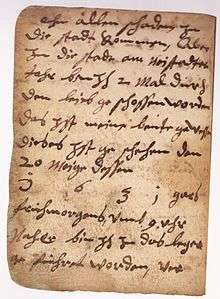Peter Hagendorf

Peter Hagendorf was a German mercenary soldier in the Thirty Years' War. He wrote a diary which gives a unique historic record of the life in the contemporary army from the viewpoint of a simple Landsknecht.
His writings were found by chance in 1993 in the manuscript store of the Berlin State Library. The surviving part covers a range of 25 years between 1625 and 1649. The book was folded from 12 sheets of paper which he bought at the end of the war in 1648 to write a fair copy of his notes. The 192 pages tell of a 22,500 km long journey across Europe filled with battles in Italy, the German states, Spanish Netherlands and France. He took part in the Sack of Magdeburg (the devastation was so great that "magdeburgization" became an oft-used term signifying total destruction, rape and pillaging for decades) and the Battle of Nördlingen (1634).[1] He details a life on the verge of death which includes his first wife and seven of his children.
The diary was anonymous. However the author had written down the dates and places of the birth his daughters and where his wife came from. As for one proof the diary says that his daughter Magreta was born on 3. November 1645 in Pappenheim and by chance the church register of that town had survived the war. It has an entry for an Anna Marget on that day with a mother named Anna Maria (equivalent with his wife's name) denoting Peter Hagendorf as the father. Other sources support the notion, for example the first church register (1629–1635) of Engelrod (Lautertal) has the following christening entry: „Eichelhain, Anno 1629, August 17., Elisabeth, Peter Hagendorffs, eines Soldaten von Zerbst Döchterlein ...“
Based on Hagendorf's writing it is now known that many women and children followed in the baggage train, how the division of responsibilities was organized between men and wife in the army camp, how the treatment of wounds was organized, how sieges were announced and how the sack (looting) of an overpowered city took place. Hagendorf fought for the most part in Pappenheim's regiment.
Extract
|
In Walde fur Magdeborgk, Alda Ist vnser haubtman, fur eine schannse todt, nebhen Ihrer viel, geschossen worden. [..] den 20 Meige, haben wir mit ernst angesedtzet vndt gesturmet vndt auch erobert, da bin Ich mit sturmer handt ohn allen schaden, In die stadt kommen. Aber in die stadt am neistadter tohr bin Ich 2 Mal durch den leieb geschossen worden das Ist meine beute gewesen. [..] Nachher bin Ich In das leger gefuhret worden, verbunden, den einmal, bin Ich durch den bauch, forne durch geschossen, zum andern durch beide agslen, dass die Kugel, Ist In das hembte gelehgen, Also hat mir der feldtscher, die hende auff den Rugken gebunden, das er hat können Meissel, einbringen, Also bin Ich In meiner hudten gebracht worden, halb todt. [..] wie Ich nun verbunden bin, Ist mein weieb In die Stadt gegangen, da sie doch vber all gebrunnen hat [..] Auff den Abendt sindt nun meine gespan kommen, hat mir ein leder edtwas verehret, einen tall oder halben tall. |
In the woods of Magedeburg, there our captain was shot dead for one of the entrenchments of the many there were. [..] on the 20th of may we earnestly engaged and stormed and also seized, there I came into town with storming hand without scathe. But in the town at the Newtown Gate I was shot two times in the body as this was my loot. [..] Later I was lead into the camp, bandaged, for one I was shot in the stomach, and for the other through both axels that the bullet laid in the shirt. So the feldscher (army surgeon) bound my hands on the back so that he could insert the chisel (forceps). As that I was brought back to my shelter half dead. [..] As I was bandaged, my wife went into the town even that it was burning all over. [..] In the evening (it was that) my companions came and each of them bestowed me something, a thaler or half a thaler. |
Literature
- Peter Burschel: Himmelreich und Hölle. Ein Söldner, sein Tagebuch und die Ordnungen des Krieges. In: Benigna von Krusenstjern, Hans Medick (Hrsg.): Zwischen Alltag und Katastrophe. Der Dreißigjährige Krieg aus der Nähe. 2. Auflage, (Veröffentlichungen des Max-Planck-Instituts für Geschichte, Band 148), Vandenhoeck & Ruprecht, Göttingen 2001, S. 181–194, ISBN 3-525-35463-0.
- Tryntje Helfferich: The Thirty Years War: A Documentary History. Hackett Publishing, Cambridge 2009, pp. 274–302.
- Hans-Christian Huf: Mit Gottes Segen in die Hölle – Der Dreißigjährige Krieg. Ullstein-Verlag, Berlin 2001.
- Jan Peters (Hrsg.): Ein Söldnerleben im Dreißigjährigen Krieg. Eine Quelle zur Sozialgeschichte. (Selbstzeugnisse der Neuzeit. Quellen und Darstellungen zur Sozial- und Erfahrungsgeschichte), Akademie Verlag, Berlin 1993, ISBN 3-05-001008-8, Inhaltsverzeichnis als PDF-Datei
References
- ↑ Helfferich, Tryntje, The Thirty Years War: A Documentary History (Cambridge, 2009), pp. 283-4, 288-9.
External links
- Das Leben eines Söldners im Dreißigjährigen Krieg, Magisterarbeit von Marco v. Müller (pdf)
- GEO EPOCHE showing a number of excerpts from his diary available for download (pdf)
- interview with Prof. Dr. Jan Peters (mp3)